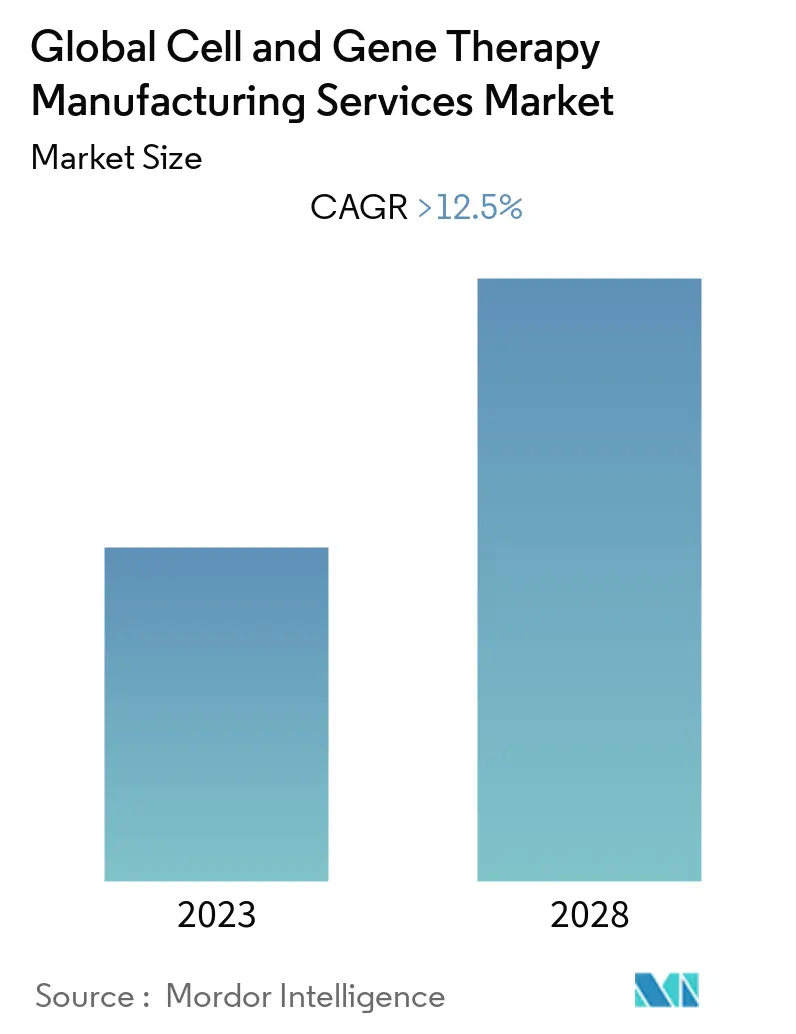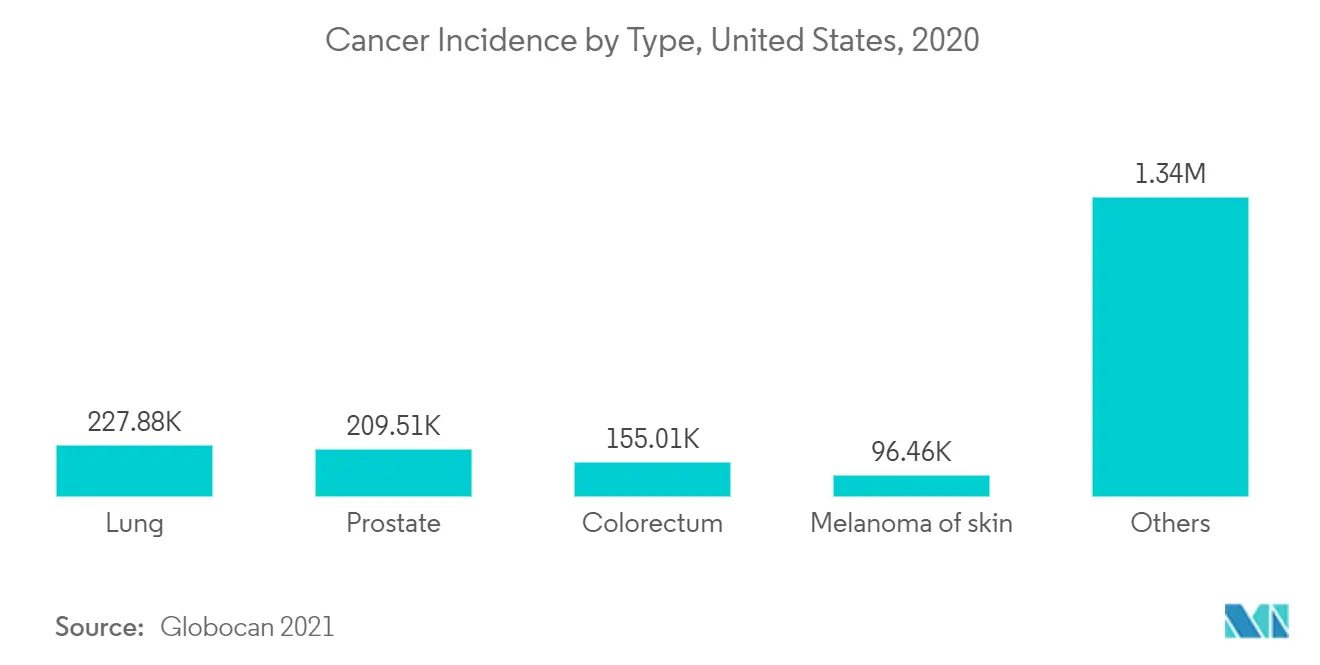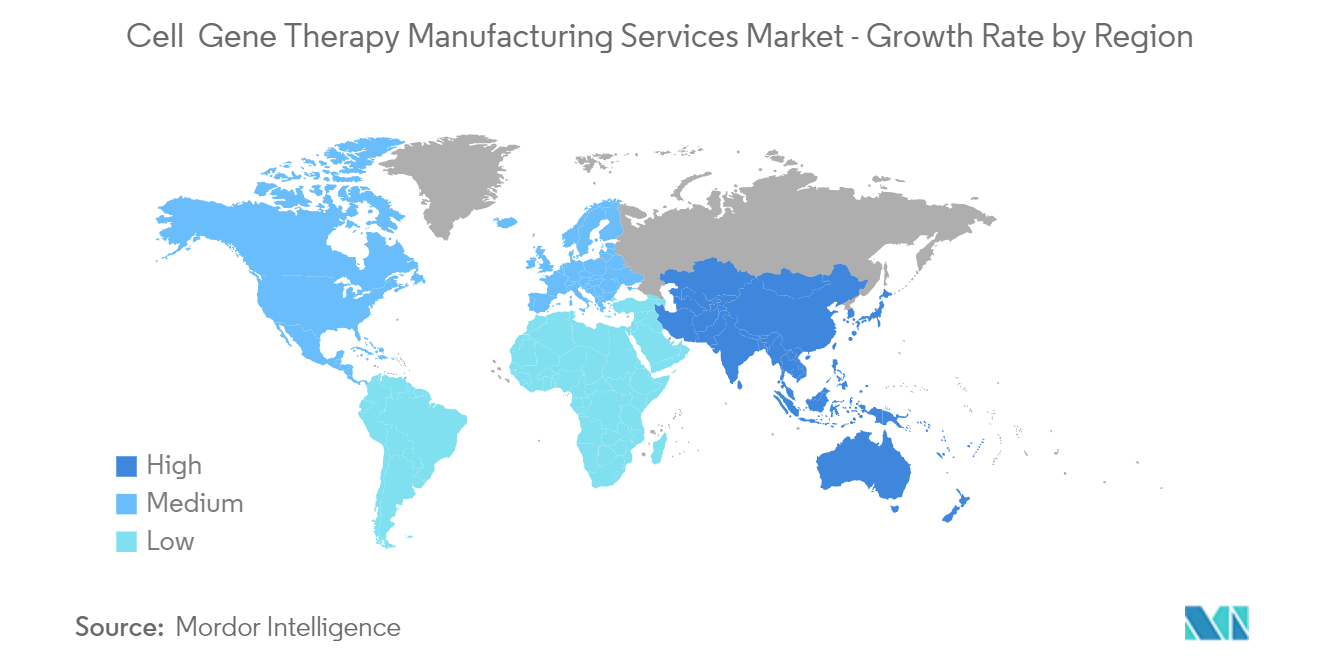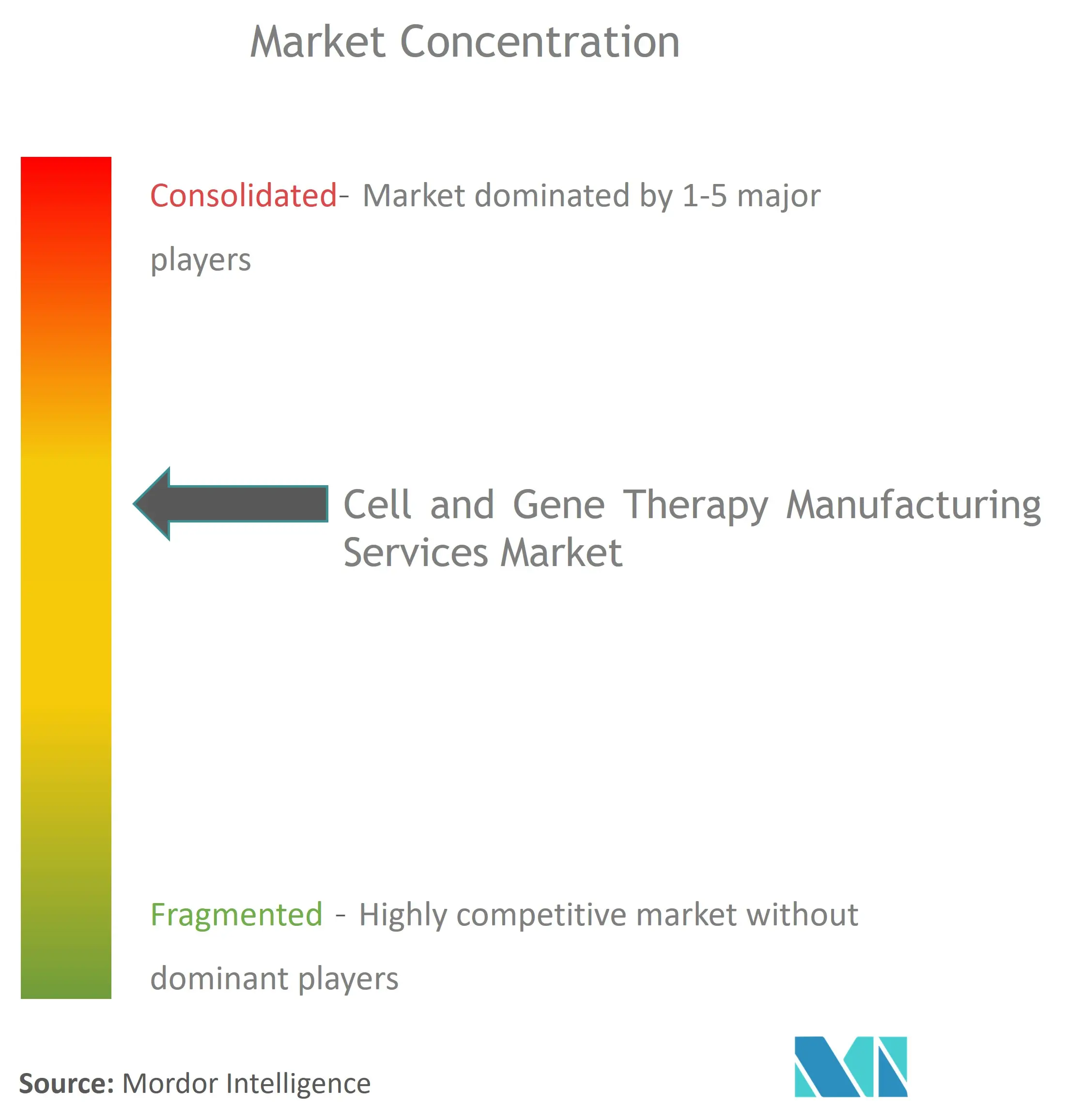Cell & Gene Therapy Manufacturing Services Market Size

| Study Period | 2018 - 2028 |
| Base Year For Estimation | 2021 |
| CAGR | > 12.50 % |
| Fastest Growing Market | Asia-Pacific |
| Largest Market | North America |
| Market Concentration | Low |
Major Players.webp)
*Disclaimer: Major Players sorted in no particular order |
Need a report that reflects how COVID-19 has impacted this market and its growth?
Cell & Gene Therapy Manufacturing Services Market Analysis
The cell and gene therapy manufacturing services market is projected to register a CAGR of 12.5% during the forecast period (2022-2027).
During the COVID-19 pandemic, the cell and gene therapy manufacturing services market was adversely affected. There were two primary reasons for that, the limited running capacity protocols introduced by the governments and the disruption of supply chain and logistics processes. According to the Coronavirus Treatment Acceleration Program (CTAP) 2020 by the United States Food and Drug Administration, COVID-19-related therapies have cell therapy products, including cellular immunotherapies and other types of autologous and allogeneic cells, such as stem cells, and related products. Thus, with the treatment of COVID-19 with cell therapy products, the demand for manufacturing services increases, which is expected to significantly impact market growth. Furthermore, in April 2022, the United States Food and Drug Administration (FDA) granted clearance to BioCardia’s Investigational New Drug (IND) application to commence a Phase I/II clinical trial of COVID-19 stem cell therapy, BCDA-04, in adults recovering from COVID-19-linked acute respiratory distress syndrome (ARDS). These new IND applications in the treatment of COVID-19 will help to increase contract manufacturing services among companies.
Certain factors that are driving the market growth include the high prevalence of cancer and other target diseases and Increasing R&D investments in pharmaceutical companies. International Agency for Research on Cancer (IARC) updated GLOBOCAN 2020 with new estimates about the global cancer burden, which indicates that the number increased to 19.3 million cases. This new study suggests that more than 50 million people are living five years with a cancer diagnosis. Some of the common factors for increasing cancer cases globally are aging populations and socio-economic risk factors. Additionally, as per the same source mentioned above, breast cancer represents 1 in 4 cancers diagnosed among women globally. Due to this, for the first time, female breast cancer has become the most commonly diagnosed cancer across the world, surpassing lung cancer because of its high prevalence in low- and middle-income countries (LMICs). Since oncology is one of the most complicated disorders known to man, cell and gene therapy is one of the fields that shows huge potential in the treatment of cancer. Cancer treatment can be done via three different gene therapy treatment approaches immunotherapy, gene transfer, and oncolytic virotherapy. As the cases will increase, the reliance on gene therapy would also increase, thus, boosting the growth of the market. Furthermore, as per the report published by the Journal of Orthopedic Surgery and Research in October 2021 titled "The Global Prevalence of Osteoporosis in the World: A Comprehensive Systematic Review and Meta-analysis," the prevalence of osteoporosis in the world was reported to be 18.3%. Stem cell therapy for osteoporosis could potentially reduce the susceptibility to fractures. Thus, with the rising burden of orthopedic disorders, the demand for cell and gene therapy manufacturing services is also expected to grow.
Similarly, there is a huge increase in research and development of cell and gene therapy products in pharmaceutical and biotechnology companies. According to the United States Food and Drug Administration (USFDA), there is a huge surge in cell and gene therapy products entering early development. Due to the aforementioned factors, the market is estimated to witness a healthy growth rate during the forecast period.
Thus the above-mentioned factors are expected to drive the growth of the studied market during the forecast period.
Cell & Gene Therapy Manufacturing Services Market Trends
This section covers the major market trends shaping the Cell & Gene Therapy Manufacturing Services Market according to our research experts:
The Allogeneic Segment is Expected to Hold a Major Market Share in the Cell Therapy Segment
The cell and gene therapy manufacturing services market is broadly segmented into cell therapy and gene therapy. Allogeneic therapies rely on a single source of cells to treat many patients. They increase the risk of eliciting an immune response within a patient, and immunosuppressive therapies are sometimes administered with allogeneic products.
Therefore, the increasing inclination of physicians toward the therapeutic use of allogeneic therapies and rising awareness about the use of cord cells and tissues across various therapeutic areas are some of the major factors driving growth. Allogenic cells have benefits as they produce their immune stem cells that kill the cancer cells that remain even after high-dose treatment with cytotoxic drugs. The primary factors driving the growth are increasing awareness about allogeneic cell therapy, growing to fund new cell lines, increasing partnerships and acquisitions, and the development of advanced genomics methods for cell analysis.
For instance, in January 2022, Century Therapeutics and Bristol-Myers Squibb signed a research collaboration and license agreement to develop and commercialize up to four induced pluripotent stem cell-derived, engineered natural killer cell or T-cell programs for hematologic malignancies and solid tumors. These types of collaboration and license agreements are expected to have a significant impact on the market growth of this segment.
Furthermore, in October 2020, the University of Texas MD Anderson Cancer Center and AllogeneTherapeutics Inc. signed a strategic five-year collaboration agreement for the preclinical and clinical investigation of AlloCART candidates across Allogene’sbroad portfolio of hematologic and solid tumors.
Thus, all the above partnerships, collaborations, and license agreements among the companies are expected to augment cell therapy manufacturing services through the segment.

North America is Expected to Hold a Significant Share in the Market and Expected to do Same in the Forecast Period
The United States is the most affected country across the world, as gene therapies are widely used in diagnostic, therapeutic, drug discovery, or other research for oncology and other clinical disorders. Thus, the demand for the same will be significantly high in the North American region, as the patient population is increasing compared to other countries.
North America is expected to hold a major market share in the global cell and gene therapy manufacturing services market due to the rise in the geriatric population, the increasing prevalence, and the incidence of infectious diseases in this region. In 2020, the United States held the major share in the North American cell and gene therapy manufacturing services market, and this trend will remain in the forecast period as well. The incidence of chronic diseases, like cancer, is also high in the United States. As per the 2020 report by the American Cancer Society, there were an estimated 1,762,450 new cancer cases diagnosed.
Moreover, the increase in research and development activities and the presence of favorable healthcare infrastructure are fueling the growth of the overall regional market to a large extent. For instance, according to a paper named "Profitability of Large Pharmaceutical Companies Compared With Other Large Companies," published in March 2020, during the first three quarters of 2020, the biotech companies got USD 15.9 billion compared to USD 13.5 billion in 2018 for the same period. According to the Alliance for Regenerative Medicine, most of this funding was public financing to support the development of cancer-related treatments.
Thus the above mentioned factors are expected to drive the growth of the market in this region.

Cell & Gene Therapy Manufacturing Services Industry Overview
The cell and gene therapy manufacturing services market is consolidated and competitive and consists of several major players. In terms of market share, a few of the major players are currently dominating the market. Some of the companies which are currently dominating the market are Thermo Fisher Scientific Inc., Merck KGaA, Charles River Laboratories, Lonza, Catalent Inc., Takara Bio Inc., and F. Hoffmann-La Roche Ltd.
Cell & Gene Therapy Manufacturing Services Market Leaders
Charles River Laboratories
F. HOFFMANN-LA ROCHE LTD.
FUJIFILM Holdings Corporation
Merck KGaA
Thermo Fisher Scientific Inc.
*Disclaimer: Major Players sorted in no particular order

Cell & Gene Therapy Manufacturing Services Market News
- In January 2022, AllogeneTherapeutics Inc. a clinical-stage biotechnology company pioneering the development of allogeneic CAR T products for cancer, and AntionBiosciences Inc. entered into an exclusive collaboration and global license agreement for Antion’smiRNA technology (miCAR) to advance multiplex gene silencing as an additional tool to develop next-generation allogeneic CAR T products.
- In May 2021, Charles River Laboratories acquired Vigene Biosciences Inc. (a cell and gene therapy CDMO), to increase its cell and gene therapy manufacturing capabilities.
Cell & Gene Therapy Manufacturing Services Market Report - Table of Contents
1. INTRODUCTION
1.1 Study Assumptions and Market Definition
1.2 Scope of the Study
2. RESEARCH METHODOLOGY
3. EXECUTIVE SUMMARY
4. MARKET DYNAMICS
4.1 Market Overview
4.2 Market Drivers
4.2.1 High Prevalence of Cancer and Other Target Diseases
4.2.2 Increasing Grants and R&D Investments in the Pharmaceutical Sector
4.2.3 Increasing Organic and Inorganic Developments Between Pharmaceutical Companies and CDMOs
4.3 Market Restraints
4.3.1 High Operational Costs Associated with the Cell and Gene Therapy Manufacturing
4.4 Porter's Five Forces Analysis
4.4.1 Threat of New Entrants
4.4.2 Bargaining Power of Buyers/Consumers
4.4.3 Bargaining Power of Suppliers
4.4.4 Threat of Substitute Products
4.4.5 Intensity of Competitive Rivalry
5. MARKET SEGMENTATION (Market Size by Value – USD million)
5.1 By Service Type
5.1.1 Cell Therapy
5.1.1.1 Allogeneic
5.1.1.2 Autologous
5.1.1.3 Viral Vector
5.1.2 Gene Therapy
5.1.2.1 Non-viral Vectors
5.1.2.2 Viral Vectors
5.2 By Application
5.2.1 Clinical Manufacturing
5.2.2 Commercial Manufacturing
5.3 By Indication
5.3.1 Oncology Diseases
5.3.2 Cardiovascular Diseases
5.3.3 Orthopedic Diseases
5.3.4 Infectious Diseases
5.3.5 Other Indications
5.4 By End User
5.4.1 Pharmaceutical and Biotechnology Companies
5.4.2 Academic and Research Institutes
5.4.3 Other End Users
5.5 Geography
5.5.1 North America
5.5.1.1 United States
5.5.1.2 Canada
5.5.1.3 Mexico
5.5.2 Europe
5.5.2.1 Germany
5.5.2.2 United Kingdom
5.5.2.3 France
5.5.2.4 Italy
5.5.2.5 Spain
5.5.2.6 Rest of Europe
5.5.3 Asia-Pacific
5.5.3.1 China
5.5.3.2 Japan
5.5.3.3 India
5.5.3.4 Australia
5.5.3.5 South Korea
5.5.3.6 Rest of Asia-Pacific
5.5.4 Middle East and Africa
5.5.4.1 GCC
5.5.4.2 South Africa
5.5.4.3 Rest of Middle East and Africa
5.5.5 South America
5.5.5.1 Brazil
5.5.5.2 Argentina
5.5.5.3 Rest of South America
6. COMPETITIVE LANDSCAPE
6.1 Company Profiles
6.1.1 Catalent Inc.
6.1.2 CELL AND GENE THERAPY CATAPULT
6.1.3 Charles River Laboratories
6.1.4 F. HOFFMANN-LA ROCHE LTD
6.1.5 FUJIFILM Holdings Corporation
6.1.6 Lonza
6.1.7 Merck KGaA
6.1.8 Nikon CeLL innovation Co. Ltd
6.1.9 Oxford Biomedica PLC
6.1.10 Takara Bio Inc.
6.1.11 Thermo Fisher Scientific Inc.
6.1.12 WuXi AppTec
- *List Not Exhaustive
7. MARKET OPPORTUNITIES AND FUTURE TRENDS
Cell & Gene Therapy Manufacturing Services Industry Segmentation
As per the scope of this report, cell therapy aims to treat disorders and diseases by restoring or changing certain groups of cells or by providing cells to carry therapy through the body. With cell therapy, cells are formed or modified outside the body before being introduced into the patient. The cells may derive from the patient (autologous cells) or a donor (allogeneic cells). Gene therapy aims to treat disorders by replacing or introducing genes into cells— either inside the body (in vivo) or outside of the body (ex vivo). The Cell and Gene Therapy Manufacturing Services Market is segmented by Type (Cell Therapy (Allogeneic, Autologous, and Viral Vector) and Gene Therapy (Non-viral Vectors and Viral Vectors)), Application (Clinical Manufacturing and Commercial Manufacturing), Indication (Oncology Diseases, Cardiovascular Diseases, Orthopedic Diseases, Ophthalmology Diseases, Central Nervous System Disorders, Infectious Diseases, and Other Indications), End User (Pharmaceutical and Biotechnology Companies, Academic and Research Institutes, and Other End Users), and Geography (North America, Europe, Asia-Pacific, Middle-East and Africa, and South America). The market report also covers the estimated market sizes and trends for 17 different countries across major regions, globally. The report offers the value (in USD million) for the above segments.
| By Service Type | |||||
| |||||
|
| By Application | |
| Clinical Manufacturing | |
| Commercial Manufacturing |
| By Indication | |
| Oncology Diseases | |
| Cardiovascular Diseases | |
| Orthopedic Diseases | |
| Infectious Diseases | |
| Other Indications |
| By End User | |
| Pharmaceutical and Biotechnology Companies | |
| Academic and Research Institutes | |
| Other End Users |
| Geography | ||||||||
| ||||||||
| ||||||||
| ||||||||
| ||||||||
|
Cell & Gene Therapy Manufacturing Services Market Research FAQs
What is the current Global Cell and Gene Therapy Manufacturing Services Market size?
The Global Cell and Gene Therapy Manufacturing Services Market is projected to register a CAGR of greater than 12.5% during the forecast period (2023-2028).
Who are the key players in Global Cell and Gene Therapy Manufacturing Services Market?
Charles River Laboratories, F. HOFFMANN-LA ROCHE LTD., FUJIFILM Holdings Corporation, Merck KGaA and Thermo Fisher Scientific Inc. are the major companies operating in the Global Cell and Gene Therapy Manufacturing Services Market.
Which is the fastest growing region in Global Cell and Gene Therapy Manufacturing Services Market?
Asia-Pacific is estimated to grow at the highest CAGR over the forecast period (2023-2028).
Which region has the biggest share in Global Cell and Gene Therapy Manufacturing Services Market?
In 2023, the North America accounts for the largest market share in the Global Cell and Gene Therapy Manufacturing Services Market.
Global Cell and Gene Therapy Manufacturing Services Industry Report
Statistics for the 2023 Global Cell and Gene Therapy Manufacturing Services market share, size and revenue growth rate, created by Mordor Intelligence™ Industry Reports. Global Cell and Gene Therapy Manufacturing Services analysis includes a market forecast outlook to 2028 and historical overview. Get a sample of this industry analysis as a free report PDF download.
